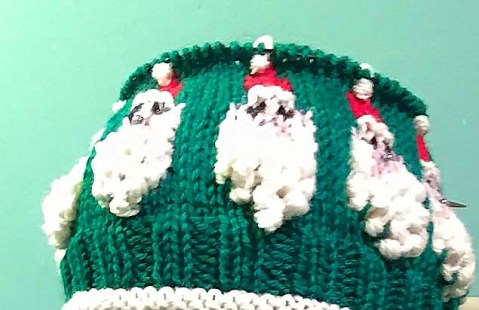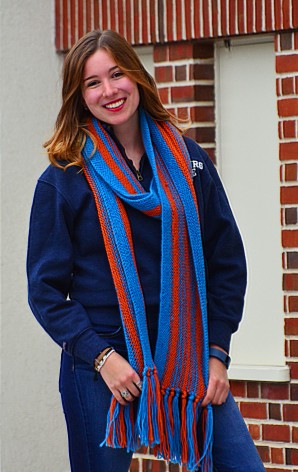Until Tuesday, November 28 (which is rapidly approaching), there are thousands of patterns at 25% off on Ravelry through the annual Indie Designer Gift-Along on Ravelry. I have looked through them all, with the idea of making a few of them. I wanted to show you some of my favorites. (For the last few days, I have been planning to add pictures for each one, but work has been busy and the sale ends tomorrow, and I’m getting worried that this won’t happen at all, so I’ll let you click on links, and you can look at the pictures on Ravelry. It’ll be like a treasure hunt.)
I chose patterns that for the most part would be quick to make, and that had something that interested me, such as a cool design feature. I left out many stunning patterns, but when there are over 3,000 choices, you have to narrow it down somehow.
Hats
There are 5 hats that I particularly loved. The first, the All Ribbed Up hat, is quick and easy. I loved the creative use of ribbing. And it’s pretty, too!
https://www.ravelry.com/patterns/library/all-ribbed-up-hat
I’m a bird person, and the Passerine hat is one that I’ve been looking at ever since it came out. It’s so pretty! There is no way I’d have time to make it by Christmas, but if it’s for me… well… there’s time.
https://www.ravelry.com/patterns/library/passerine-hat
Okay! Back to gift-giving! The messy-bun hat is out there in many versions, but I thought this one had a nice little detail on the side:
https://www.ravelry.com/patterns/library/catalina-messy-bun-hat
This hat is completely intriguing, and I absolutely love the name:
https://www.ravelry.com/patterns/library/splat-hat
And finally, I have no idea who I’d give this to, but it is so stinkin’ cute I can hardly stand it.
https://www.ravelry.com/patterns/library/bunny-ears-hat-3
Cowls
Let’s look now to cowls, always a classic gift. This one is pretty:
https://www.ravelry.com/patterns/library/silver-falls-cowl
I’ve always loved Katy’s designs. Her Compulsive Cowl is no exception, and it does look as if I would be compulsive about knitting it (although admittedly, this is not exactly unusual knitting behavior):
https://www.ravelry.com/patterns/library/compulsive-cowl
And this one looks like lots of fun (I’m guessing that you have some hand-dyed yarn sitting around):
https://www.ravelry.com/patterns/library/davinci-cowl
Mitts
I love these mitts!
https://www.ravelry.com/patterns/library/hot-cross-mitts
And these have welts, which I would definitely be swooning over if I were the swooning type (what I lack in drama, I make up for in practicality):
https://www.ravelry.com/patterns/library/world-war-gloves
Jewelry
I don’t crochet super-often, but I’m thinking about it with this pretty bracelet. It would go quickly:
https://www.ravelry.com/patterns/library/slap-chop
If you don’t crochet but like jewelry, this necklace is soooooo pretty! It’s almost a collar.
https://www.ravelry.com/patterns/library/saqqara-necklace
3-D Projects
If you want to make items that are more sculptural, here are a few ideas:
Tulips!
https://www.ravelry.com/patterns/library/spring-tulip-pattern
Gnomes! They. Are. So. Cute.
https://www.ravelry.com/patterns/library/never-not-gnoming
Feet
Like to make feet and leg things? Here are a couple of ideas that would be quicker than socks:
Slippers: https://www.ravelry.com/patterns/library/dinar
Sometimes I think I should make myself boot cuffs. I’ve never quite understood them, but they are popular enough that I have the feeling they might be useful. Have you ever made them? What do you think? Do you wear them?
Boot cuffs: https://www.ravelry.com/patterns/library/entangled-boot-cuffs
Shawl
I almost didn’t include any shawls, even though there were so many beautiful ones, because a shawl would take pretty long for a gift, but this one is graphically amazing. (See above about the Passerine hat plot.)
https://www.ravelry.com/patterns/library/cascadian-2
For the Home
Baskets are useful for anyone!
https://www.ravelry.com/patterns/library/poldi-basket
Sadly, we are almost at the end. (I don’t know about you, but I’m glad that knitting patterns never really end.) And this final one for today is a simple, excellent idea. It would go fast, and it’s very, very pretty, and you get to buy fancy soap and decide on just the right scent:
https://www.ravelry.com/patterns/library/bubbly-scrubber
Have fun looking at all the gift-along items! You might find even more. Check out the group on Ravelry: https://www.ravelry.com/groups/indie-design-gift-a-long.
Even if you have read this too late and miss out on the sale, it’s not that big a deal, given the joy you get from knitting for the still-small price of a pattern. (Best of all, paying designers keeps them working for you. And eating. And buying yarn.)
There are all kinds of Gift-Along events happening throughout December. So plunge in wherever you are!
 Sometimes it’s nice to work on a knitting project that’s easy. It can give you something to do after a hard day. Or it lets you pick up and keep working, even if your project’s been neglected for a few days, without having to struggle to remember what you were doing.
Sometimes it’s nice to work on a knitting project that’s easy. It can give you something to do after a hard day. Or it lets you pick up and keep working, even if your project’s been neglected for a few days, without having to struggle to remember what you were doing.








 I’ve learned from knitting that mistakes are part of knitting. There are times when you’re tired and skip an instruction, or your gauge is off, or you use the wrong yarn for the project, or the dog eats your knitting… The list goes on. The question is, what do you do about these problems? Here are a few tips.
I’ve learned from knitting that mistakes are part of knitting. There are times when you’re tired and skip an instruction, or your gauge is off, or you use the wrong yarn for the project, or the dog eats your knitting… The list goes on. The question is, what do you do about these problems? Here are a few tips.



